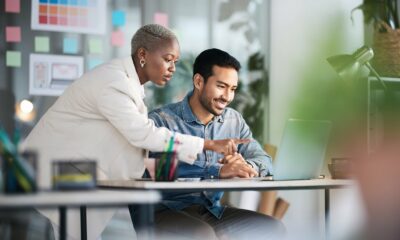MARKETING
How To Explain Content Marketing ROI to Win (or Keep) Buy-In

Updated March 15, 2022
Many key figures for buy-in and implementation of content marketing still don’t even know what content marketing is or why it’s a worthy investment.
That could well affect why only 26% of B2B and 29% of B2C marketers rate their content marketing as extremely or very successful in the latest CMI research. If you can’t get initial buy-in, if you don’t get enough support behind your content efforts, how can you be successful?
Explaining the nitty-gritty inner workings and ROI of both content marketing and content strategy to bosses or clients is difficult for everybody. This difficulty multiplies, especially when you want to get your content strategy off the ground. And if you can’t find the right way to explain ROI, you may never move past “go.”
If you can’t explain #ContentMarketing, #ContentStrategy, and ROI to executives, you may never move past go, says @JuliaEMcoy via @CMIContent. Click To Tweet
Being able to explain content marketing’s worth and rewards can make all the difference in this situation. How do you explain content marketing and its ROI? How can you phrase this explanation in a way that’s persuasive, urgent, and incredibly convincing?
Fear not. There ARE ways to make it happen.
1. Explain content marketing and strategy in understandable terms
Start with the basics in your explanation of content marketing and strategy. Metaphors are always a great way to relate new concepts to something people already know. Here’s an apt one for the content duo:
If content marketing is a vehicle, content strategy is its engine. The vehicle can transport you to your destination (i.e., goals), but it needs an engine to get you there.
Perhaps the goal is to increase organic traffic to your brand website – your destination.
- The vehicle to get there is content marketing.
- The engine that powers content marketing is your content strategy. In this example, the strategy might be to blog three times a month, targeting keywords your desired audience uses in its searches.
- The ROI for your engine-powered vehicle is measured by the increase in average monthly visitors to the site over a predetermined time in your content strategy.
Simply and succinctly breaking down content marketing and content strategy with this analogy gives your bosses or clients a ground-floor understanding of how it all works.
#ContentMarketing is the vehicle. #ContentStrategy is the engine that powers the vehicle. Your goal is the destination, says @JuliaEMcoy via @CMIContent. Click To Tweet
After you lay it out, though, you need to dig in and really show them why it works and why they should care.
2. Use these methods to demystify content marketing ROI
All the metaphors in the world won’t help you explain content marketing and its worth if you aren’t using language your boss, clients, or higher-ups understand. Here are some other approaches that help show how content marketing works and make them care.
Gather evidence (case studies, examples, stats, and more)
To drive home the impact and potential of content marketing for whoever needs convincing, show them the numbers, don’t talk about the potential.
Gather examples of other businesses and individuals who have used content marketing to bolster their brand success. These are easy enough to find online. Search for case studies that show the true gains from content in terms of hard data.
For example, this CMI article looks at four companies that shared the results from their content marketing campaigns. The article shares concrete examples of the content each company created, plus the major results each campaign netted. For example, software development agency Coding Sans shared that its 2019 State of Software Development report attracted 5,000 downloads, 291 backlinks, and an estimated $300,000 in new projects.
Phrase your argument in terms of what your boss or client will gain
For your content argument to win, you need to emphasize what your boss/client/stakeholder will gain from it.
To win the argument for #content, emphasize what your boss will gain from it, says @JuliaEMcCoy via @CMIContent. Click To Tweet
As Gary Williams and Robert Miller write Harvard Business Review: “All too often, people make the mistake of focusing too much on the content of their argument and not enough on how they deliver that message.”
The right delivery is key for achieving content marketing buy-in. Don’t just gather all the examples and throw them like a pitcher throwing fastballs. Think about the key person you’re trying to convince and tailor your argument for them.
Present examples that will appeal to their interests and knowledge. Then, describe how a tailored content strategy for the brand will drive traffic, build relationships with an audience, create leads, and ultimately pull in new customers. Emphasize whichever of these results that person will deem most important.
HANDPICKED RELATED CONTENT:
3. Predict the ROI on implementing (or continuing to invest in) content marketing
If the higher-ups want to know how you’ll show the ROI of content marketing in hard numbers, don’t despair. You can estimate the eventual payoff for the brand depending on what they invest in content marketing at the outset.
Let’s get into the formula you need to follow for confidently making this prediction. This is where you literally show them the money.
Hit them with a tested formula for predicting ROI
Here’s the foundation of the content marketing ROI formula: conversions.
Conversions are a basic metric to determine the success of a content marketing strategy. You can use content marketing to:
- Attract or increase traffic to a site.
- Convert that traffic into high-quality leads.
- Convert those leads into sales.

If you can quantify conversions in terms of their potential sales, you can estimate the eventual ROI from investment in a content marketing strategy.
Benchmarks
Benchmark numbers help you determine conversion potential. For this formula, use data that quantifies two big parts of the conversion process:
- Your industry’s average conversion rate to high-quality leads (the ones most likely to become sales)
- Your company’s average rate of high-quality leads that convert to sales
Use these numbers, plus monthly traffic numbers from your brand, to predict content marketing ROI in the form of projected leads and sales.
Formula
To estimate earned leads per month:
- Number of monthly visitors multiplied by (average traffic-to-leads conversion rate) = X leads per month
To estimate sales per month from those leads:
- Number of monthly leads multiplied by (average lead-to-sale conversion rate) = X sales per month
4. Use numbers to encourage investment in content marketing
Sure, showing the ROI potential of content marketing is great, but it won’t hit home unless you also show why it’s better than other types of marketing investments. Here’s how to do that:
Estimate the investment
Up-front investment is necessary for content marketing. Show what that investment will look like.
For example, if you pay about $375 on average for one authority content piece every week, the total yearly investment for content creation is $19,500. (I’m using this single cost to simplify the example. You should consider all related costs for publishing, promotion, etc.)
Explain what the investment will produce
Now, outline what the company will get from that investment.
For example, show that your content creation will focus on high-performing keywords (low competition, high search volume). Assume you’ll hit at least the third position in Google rankings within a year for at least two-thirds of those targeted keywords (34 out of 52, give or take a few).
If each of those higher-ranking keywords has a search volume of 1,500 a month, you could expect a CTR (click-through rate) of 11%, according to Sistrix data.
That would net a total search volume of 51,000 (34 keywords multiplied by 1,500 searches per month) and an average of 5,610 monthly visitors (51,000 total search volume x 11% CTR).
HANDPICKED RELATED CONTENT:
Show why that investment is better and how it translates to ROI
Now, find out how much it would cost to reach that number of website monthly visitors through paid search.
For example, Semrush shows (with a Pro subscription) organic traffic and how much that amount of traffic would cost in paid search each month. Here’s an example from my website that shows I’d have to pay $2,400 a month for the 841 monthly organic visitors the site currently attracts. Find that number for your own organic traffic and compare it to your content costs.
To make the deal sweeter, let’s look at the ROI potential of those 5,610 monthly visitors from content marketing using the earlier conversion benchmark formulas:
- 5,610 monthly visitors x 10% (benchmark traffic-to-leads conversion rate) = 561 monthly leads
- 561 monthly leads x 15% (benchmark leads-to-sales conversion rate) = 84 monthly closed sales
(I used numbers to make the calculation easy to understand. You’ll use the numbers you gathered on relevant industry benchmarks and your own company’s lead-to-sale close rate.)
Pulling it all together
It’s time to pull it all together and create the most convincing argument possible for content marketing and strategy.
Use each facet to build your case and make it irresistible, and always phrase your argument in terms of how content will benefit your boss/clients/higher-ups/stakeholders:
- Lay out a ground-floor explanation of how content marketing and strategy work. Use relatable metaphors.
- Present examples of content from various companies AND the results netted from these campaigns. (Use hard data and stats – case studies are excellent for this.)
- Use the formulas above to predict the brand’s potential for ROI-based traffic and lead conversions. Compare those numbers to investments for other marketing tactics to get the same results.
- Accept handshakes and pats on the back for your marketing genius.
HANDPICKED RELATED CONTENT:
Cover image by Joseph Kalinowski/Content Marketing Institute














You must be logged in to post a comment Login